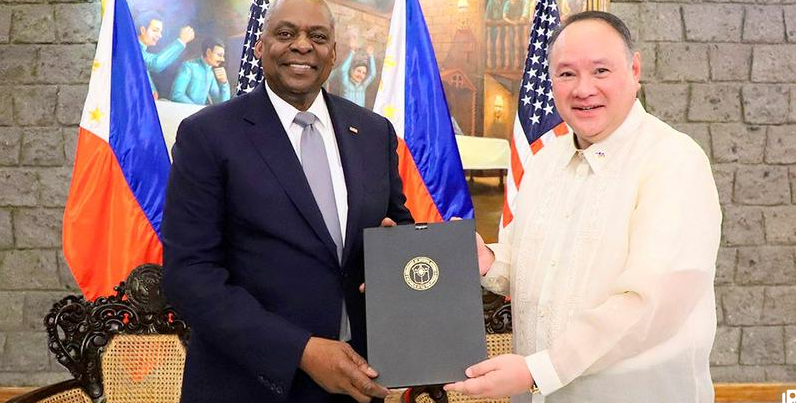1. Strengthening a Strategic Partnership
U.S., Philippines United States and the Philippines have taken a significant step toward bolstering their military alliance with a new agreement focused on sharing intelligence and advanced weapons technology. This development highlights the growing importance of their partnership amid rising tensions in the Indo-Pacific region.
2. The Scope of the Agreement
The agreement encompasses various aspects of military collaboration, including real-time intelligence sharing, joint military training programs, and access to cutting-edge weapons systems. It also paves the way for increased cooperation in cybersecurity and maritime defense, areas critical to ensuring regional stability.
3. Context of Regional Geopolitics
This agreement comes at a time when the Indo-Pacific is witnessing heightened geopolitical tensions, particularly due to China’s growing assertiveness in the South China Sea. The Philippines, a claimant to disputed territories in the region, sees the partnership with the U.S. as a way to strengthen its defensive posture.
4. Key Provisions of the Deal
The agreement includes provisions for the exchange of intelligence data in real-time to enhance situational awareness and counter emerging threats. Additionally, the U.S. will provide the Philippines with access to advanced weapons technology, including drones, missile systems, and radar equipment.
5. Boosting the Philippines’ Military Capabilities
For the Philippines, this deal represents a major leap in modernizing its military capabilities. With a traditionally under-resourced defense sector, the partnership with the U.S. offers opportunities to acquire state-of-the-art equipment and improve operational readiness.
6. Mutual Benefits for the U.S.
The agreement allows the U.S. to strengthen its strategic presence in Southeast Asia. It ensures access to key locations for military operations and intelligence gathering, enabling the U.S. to counter China’s influence effectively and maintain freedom of navigation in the South China Sea. 
7. Enhanced Maritime Defense
One of the focal points of the agreement is improving maritime defense. The Philippines will receive advanced surveillance systems and maritime patrol aircraft to monitor activities in its territorial waters, a critical aspect of addressing illegal fishing and territorial incursions.
8. Focus on Counterterrorism
Counterterrorism efforts are another priority under this agreement. Both nations aim to collaborate on identifying and neutralizing extremist groups in the region, particularly those operating in the southern Philippines.
9. Role of Cybersecurity
The agreement emphasizes cybersecurity, reflecting the growing importance of safeguarding critical infrastructure and military communications from cyberattacks. Joint efforts will include information sharing, capacity building, and developing robust defense mechanisms against digital threats.
10. China’s Reaction
China has criticized the agreement, viewing it as a move to contain its influence in the region. Beijing has warned both nations against escalating tensions and urged them to focus on dialogue and peaceful resolution of disputes.
11. The Philippines’ Perspective
For the Philippines, this partnership underscores its commitment to defending its sovereignty while balancing its relationship with neighboring countries. President Ferdinand Marcos Jr. has emphasized the need for a robust defense strategy to protect national interests.
12. U.S. Strategic Goals
For the U.S., the agreement aligns with its broader Indo-Pacific strategy, which aims to strengthen alliances and partnerships to counterbalance China’s growing power. The deal also signals Washington’s commitment to supporting its allies in the region.
13. Implications for Regional Security
The agreement has far-reaching implications for regional security. It enhances the Philippines’ ability to safeguard its territorial integrity while contributing to the collective security of Southeast Asia, a region increasingly central to global geopolitics.
14. Economic and Technological Collaboration
Beyond military cooperation, the agreement opens doors for economic and technological collaboration. It provides opportunities for joint ventures in defense manufacturing and the development of indigenous technologies.
15. Public and Political Reactions
Public opinion in both countries has been largely supportive of the agreement, though some concerns remain about potential escalation of tensions with China. Political leaders have highlighted the importance of the deal in ensuring long-term peace and stability.
16. Lessons from Past Agreements
This agreement builds on previous U.S.-Philippines defense pacts, such as the Enhanced Defense Cooperation Agreement (EDCA). Lessons from these partnerships have informed the current deal, ensuring a more comprehensive approach to addressing security challenges.
17. Challenges Ahead
Despite the positive outlook, challenges remain. Implementing the agreement effectively will require sustained political will, financial investment, and coordination between the two nations’ military and intelligence agencies.
18. Role of ASEAN
The agreement also underscores the importance of the Association of Southeast Asian Nations (ASEAN) in regional security. The U.S. and the Philippines have reaffirmed their commitment to working with ASEAN to address shared challenges and promote stability.
19. Long-Term Impact
The long-term impact of this agreement will depend on how well both nations leverage the partnership to address current and emerging threats. Success will be measured by improved defense capabilities, stronger deterrence against aggression, and enhanced regional cooperation.
20. Conclusion
The U.S.-Philippines agreement on shared intelligence and weapons technology marks a significant milestone in their bilateral relationship. As both nations navigate a complex geopolitical landscape, this partnership offers a promising path toward achieving mutual security objectives and ensuring peace in the Indo-Pacific region. ALSO READ:- At Least 9 Killed as Russian Missiles and Drones Pound Ukraine in ‘Massive’ Attack 2024